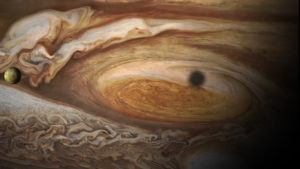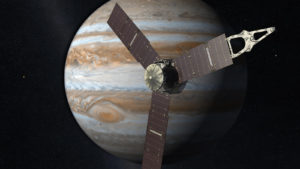
As I write this post, NASA’s Juno spacecraft has commenced the Jupiter Orbital Insertion (JOI) burn, the most perilous phase of the mission. No spacecraft has ever flown this close to Jupiter or its intense radiation belts. The Juno Mission to Jupiter, has arrived at its destination. Juno is the second spacecraft designed for NASA’s New Frontiers Program with the first being the brilliantly successful New Horizons that flew by Pluto on 14 July, 2015, ten days to the year sooner to the arrival of Juno. Unlike New Horizons however, and unlike any other spacecraft deployed beyond the orbit of Mars, Juno is powered exclusively by solar power.
Launch, Cruise and Arrival
 Launched on 5 August, 2011, the craft was put on a trajectory for an October 2013 gravity assist with Earth, a maneuver that accelerates it an additional 3.9 km/sec to 140,000 Km/hr (39 km/sec). Following this gravity assist, the vehicle enters a 792-day “quiet cruise” phase, followed by a 178-day Jupiter Approach phase, a 4-day Jupiter Orbit Insertion Phase that began yesterday, 1 July, with the journey finally culminating in a 35-minute Jupiter Orbital Insertion burn. As Juno approaches Jupiter, the giant planet’s powerful gravity will accelerate the spacecraft to a blazing 160,000 Km/hr (44.4 Km/sec or 101,000 Mi/hr) to become the fastest object ever made, breaking the previous record set by New Horizons.
Launched on 5 August, 2011, the craft was put on a trajectory for an October 2013 gravity assist with Earth, a maneuver that accelerates it an additional 3.9 km/sec to 140,000 Km/hr (39 km/sec). Following this gravity assist, the vehicle enters a 792-day “quiet cruise” phase, followed by a 178-day Jupiter Approach phase, a 4-day Jupiter Orbit Insertion Phase that began yesterday, 1 July, with the journey finally culminating in a 35-minute Jupiter Orbital Insertion burn. As Juno approaches Jupiter, the giant planet’s powerful gravity will accelerate the spacecraft to a blazing 160,000 Km/hr (44.4 Km/sec or 101,000 Mi/hr) to become the fastest object ever made, breaking the previous record set by New Horizons.
Mission Itinerary and Program
Unlike other missions such as the Galileo Mission to Jupiter where an equatorial orbit was established, Juno will be placed in a polar orbit providing for a first-time look at the Jovian poles and the opportunity for a “look down” view of active Jovian aurorae. The highly elliptical orbit will bring the spacecraft within 4,300 Km (2,688 mi) of the giant planet’s polar cloud decks. Once established in this orbit, the orbiter will begin its mission program using the suite of onboard instruments. In addition to providing a “bird’s eye view” of the Jovian polar regions, this orbit takes the spacecraft on a path that avoids any long-term exposure to Jupiter’s powerful radiation belts, regions that can damage or render inoperable the spacecraft’s primary electronics and solar panels. These electronics include communications and navigation modules and are thus placed in the “Juno Radiation Vault”, a 1 cm thick-walled cube of solid titanium.
Public Access and Participation

Black and White Test frame obtained by JunoCAM during the spacecraft’s 9 October, 2013 flyby of Earth showing sections of Central and Southern South America that include Chile and Argentina.
A key aspect of NASA’s New Frontiers Program provides the opportunity for the public to play an expanded participatory and access role in a given mission when appropriate. The opportunity for expanded public participation in a major space mission is a great opportunity for teachers, educators and students alike. As soon as the spacecraft is in a stable orbit, JunoCAM will be activated providing the very first views of the Jovian poles. Like the brilliantly successful Cassini Mission to Saturn, public participation in and contribution to the mission is encouraged and is available through an online portal. Membership in the JunoCam community is available through the online portal where you can actively participate in the mission! If you’re an amateur astronomer (or a professional) you have the opportunity to upload and share your images of Jupiter and help mission scientists decide what points of interest JunoCam will photograph.
Where is Juno Now?
To view the position of Juno (as well as the position and status of any other mission) at any given moment, the Solar System Simulator and Explorer is available through NASA JPL and the California Institute of Technology. In a related story, the Space Telescope Science Institute just released new images obtained with the Hubble Space Telescope of Aurorae occurring in Jupiter’s North Polar region. Public access to the latest available data, images and content can be found on the Juno mission public website, NASA’s website for the mission and at Space
 As a fitting conclusion and to serve as a timeless reminder of what we can accomplish, to the heights we can climb, to what we can achieve, to the indefatigable human spirit, how we will one day make it to the stars [with difficulty-ad astra per aspera], the words of Isaac Newton, that “If I have seen further it is by standing on ye shoulders of Giants”, it should be noted that Juno carries a plaque dedicated to Galileo Galilei. It was provided by the Italian Space Agency and measures 7.1 by 5.1 centimeters and is made of flight-grade aluminum with a mass of 6 grams. It depicts a portrait of Galileo and a text in Galileo’s own hand, penned in January 1610, while observing what would later be known to be the Galilean moons.
As a fitting conclusion and to serve as a timeless reminder of what we can accomplish, to the heights we can climb, to what we can achieve, to the indefatigable human spirit, how we will one day make it to the stars [with difficulty-ad astra per aspera], the words of Isaac Newton, that “If I have seen further it is by standing on ye shoulders of Giants”, it should be noted that Juno carries a plaque dedicated to Galileo Galilei. It was provided by the Italian Space Agency and measures 7.1 by 5.1 centimeters and is made of flight-grade aluminum with a mass of 6 grams. It depicts a portrait of Galileo and a text in Galileo’s own hand, penned in January 1610, while observing what would later be known to be the Galilean moons.



I enjoyed your article
Thank you!
Thankfulness to my father who informed me about this
weblog, this blog is truly remarkable.
Thank you for your thoughtful remarks.
Very soon this site will be famous among all blogging visitors,
due to it’s fastidious articles or reviews
Thank you for the confidence!